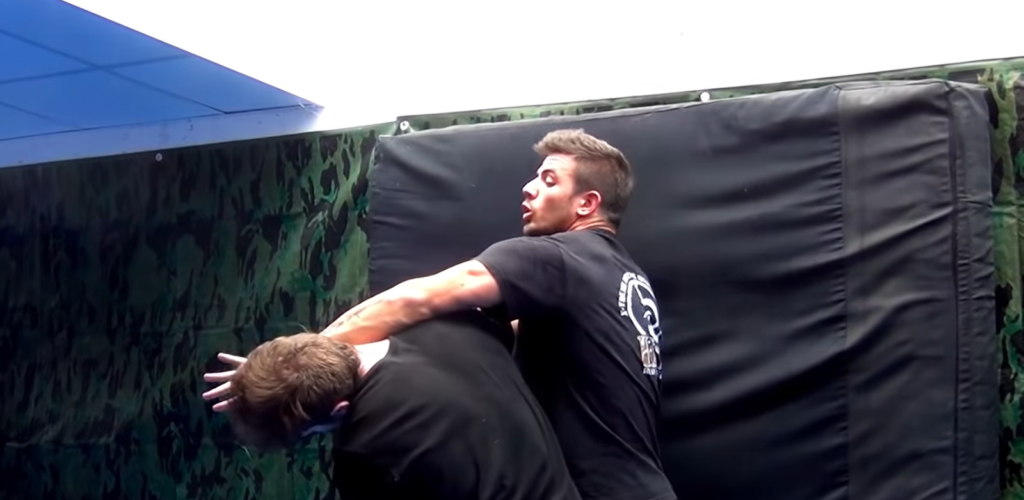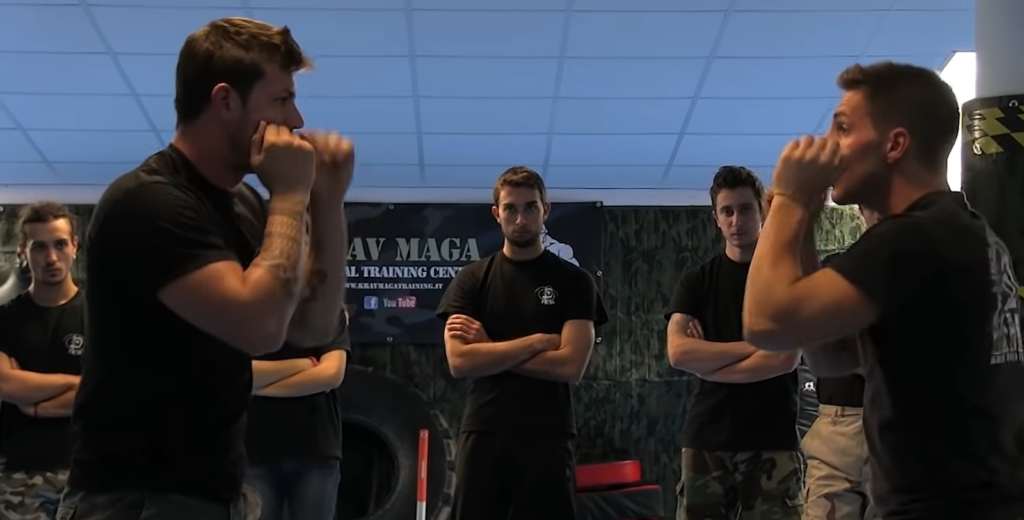Every variant of martial arts has the potential to serve as a means of self-protection. However, in contrast to the majority of practices, Krav Maga stands out for its primary emphasis on survival and inflicting discomfort.
Given that a significant portion of Krav Maga techniques are characterized as unorthodox or suitable for real-world scenarios, there’s a prevalent inquiry regarding its application within MMA circles. Does Krav Maga find a place in MMA?
Krav Maga’s Role in MMA
Krav Maga’s potential role within the MMA realm is a subject of both intrigue and caution. While certain facets of Krav Maga’s training principles and techniques can offer practical value within the context of MMA, it’s important to recognize a fundamental caveat: numerous Krav Maga techniques are explicitly prohibited within the regulated environment of MMA contests. This divergence arises from the core objective of Krav Maga instruction, which centers on empowering individuals to defend themselves in real-world scenarios, often on the streets or in hazardous situations.
The heart of Krav Maga’s ethos lies in equipping practitioners with the skills to handle unexpected confrontations, prioritize survival, and deliver effective responses against potential threats. Consequently, this self-defense discipline imparts a repertoire of techniques aimed at inflicting discomfort and disarray upon adversaries. However, this approach doesn’t always align seamlessly with the rules and constraints of MMA competitions, where fairness and safety are paramount.
Given these nuances, it’s not surprising that many fighters choose not to incorporate Krav Maga into their comprehensive training regimens for MMA. The potential benefits of certain Krav Maga techniques need to be carefully weighed against the risk of disqualification or the ethical considerations surrounding the legality of certain moves within the octagon.
For readers new to the intricacies of Krav Maga and its relationship with MMA, further exploration of this article will provide a comprehensive understanding. It delves into the specifics of Krav Maga’s unconventional techniques, sheds light on the reasons behind its limited acceptance in the structured environment of MMA, and unpacks the hesitance exhibited by fighters when it comes to blending this distinct combat discipline into their MMA preparation routines.
Understanding Krav Maga: Self-Defense and Survival
Krav Maga, a self-defense and striking method, serves as a versatile discipline aimed at empowering individuals of all ages, genders, and sizes to safeguard themselves and their loved ones in critical situations. Rooted in street fighting tactics, Krav Maga is regarded as a tool for survival, enhancing both situational awareness and instinctual responses.
Distinguished from various other practices, Krav Maga encompasses an extensive range of combat techniques, training practitioners to utilize every facet of their bodies as instruments during confrontations. When prioritizing self-protection, the objective is to inflict maximum discomfort and distress upon the assailant, employing diverse means to achieve this end.
Remarkably, even those with limited experience can quickly grasp the essentials of Krav Maga. Swift and effective training can expedite the development of proficient hand-to-hand combat skills.
- Groin strikes with knees;
- Finger and toe manipulation for joint control;
- Utilizing headbutts;
- Instruction in weapon handling;
- Eye gouging techniques.
The aforementioned elements highlight some of the more unconventional aspects within the realm of Krav Maga practice. Originally conceived to enhance the combat and self-defense proficiencies of soldiers, this discipline diverges from others primarily intended for competitive martial arts endeavors.
While various disciplines are structured to prepare individuals for martial arts competitions, Krav Maga dedicates itself to equipping people with practical skills for real-world confrontations.
Krav Maga can best be characterized as an approach where real-life application disregards limitations. There exist no constraints or regulations, and the sole objective in employing Krav Maga techniques is achieving victory.
The absence of formal regulations within Krav Maga unequivocally explains the absence of competitive events comparable to those found in disciplines like jiu-jitsu or karate, for instance.

Are Krav Maga Techniques Common Among UFC Fighters?
Currently, no prominent UFC fighters prominently integrate Krav Maga into their fighting repertoire. While a few may possess a foundation in Krav Maga training, its applicability within the octagon remains limited. An example is Karolina Kowalkiewicz, who possesses a Krav Maga background but refrains from utilizing it within the UFC.
Instead, most UFC fighters bypass Krav Maga instruction in favor of more sophisticated disciplines, refining their skills through diverse training methodologies. In direct confrontations, a UFC fighter with comprehensive training typically prevails over an opponent reliant solely on Krav Maga knowledge.
The MMA landscape comprises fighters hailing from diverse backgrounds. Wrestling, grappling, martial arts such as jiu-jitsu, karate, and taekwondo, as well as boxing and hand-to-hand combat, all contribute to their skill sets. The most successful UFC fighters invariably master multiple disciplines to excel.
Krav Maga’s unconventional nature hinders its practicality within the octagon. Many Krav Maga techniques are deemed illegal in the UFC, rendering their application unfeasible. While some UFC fighters might have acquired Krav Maga expertise before embarking on an MMA career, its integration remains uncommon due to these restrictions.
Choosing Between Krav Maga and MMA
Deciding between Krav Maga and MMA hinges on your specific needs and priorities. Generally, while MMA tends to offer a more comprehensive skill set, it requires a longer learning curve compared to Krav Maga, which can be a quicker option. MMA training equips fighters with practical self-defense abilities for real-world situations, but Krav Maga may be more suitable for non-professionals seeking self-defense skills. It’s important to note that any type of combat training can enhance self-defense capabilities, even if that’s not the primary focus of the discipline.
- In terms of competitive scenarios, MMA consistently holds the edge over Krav Maga due to its versatility. Nonetheless, Krav Maga serves its purpose effectively;
- For those seeking an accessible and expedient fighting technique, Krav Maga presents a favorable choice;
- MMA encompasses a wide array of techniques, and mastering multiple disciplines can optimize self-defense tactics in critical situations. Yet, achieving this proficiency is no simple feat;
- Considering that most individuals encountered in everyday situations lack fighting or self-defense backgrounds, someone skilled in Krav Maga would generally hold an advantage.
However, within the controlled environment of an octagon or an MMA competition, relying solely on Krav Maga techniques can lead to disqualification rather than victory. Employing them effectively during an MMA fight necessitates careful strategy.
The Relevance of Krav Maga in MMA: An Evaluation

Having extensive training is always advantageous for a UFC fighter. Acquiring knowledge in Krav Maga is also beneficial since many UFC matches revolve around grappling and defense. Certain Krav Maga techniques could potentially prove valuable for professional octagon competitors. Nonetheless, it’s worth noting that the majority of these techniques are often deemed excessively hazardous.
- Knee strikes;
- Grappling maneuvers;
- Grappling defense tactics;
- Reversals and techniques for countering takedowns;
- Fight instincts and situational awareness.
These techniques offer effective transitioning into the octagon for a fighter rooted in Krav Maga discipline. While almost any martial art or fighting style can eventually prove beneficial for a UFC fighter, an individual exclusively trained in Krav Maga should avoid confronting a seasoned MMA fighter.
As previously stated in the article, Krav Maga prioritizes winning at any cost and leans more towards self-defense than traditional martial art. Relying solely on Krav Maga in an MMA bout would likely result in swift defeat or disqualification due to employing illegal moves inherent to Krav Maga. Irrespective of one’s favored fighting approach, mastering takedown and grappling defense is imperative for a successful UFC career.
Considering this, integrating the self-defense elements of Krav Maga can indeed bolster one’s ability to defend against a fighter inclined to seek takedowns during a match.
Conclusion
Although Krav Maga proves valuable for real-life self-defense scenarios, its applicability to MMA is limited. Despite these disparities, possessing a foundation in Krav Maga can offer fighters various advantages. Nonetheless, investing additional training time in different disciplines and martial arts would be prudent.